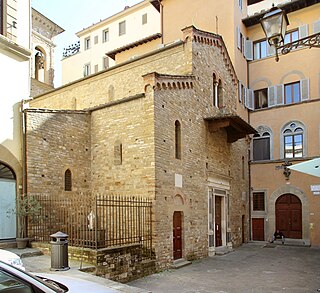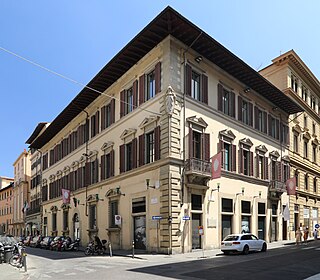
The Pazzi were a powerful family in the Republic of Florence. Their main trade during the fifteenth century was banking. In the aftermath of the Pazzi conspiracy in 1478, members of the family were banished from Florence and their property was confiscated; the family name and coat-of-arms were permanently suppressed by order of the Signoria.

The Pazzi conspiracy was a failed plot by members of the Pazzi family and others to displace the Medici family as rulers of Renaissance Florence.

The Bargello, also known as the Palazzo del Bargello or Palazzo del Popolo, is a former barracks and prison in Florence, Italy. Since 1865, it has housed the Museo Nazionale del Bargello, a national art museum.

The Church of Santi Apostoli is a Romanesque-style, Roman Catholic church in the historic center of Florence, in the Tuscany region of Italy. It is among the oldest church buildings in Florence.

Palazzo Mozzi or Palazzo de' Mozzi is an early Renaissance palace, located at the end of the Piazza de' Mozzi that emerges from Ponte alle Grazie and leads straight to the palace where via San Niccolò becomes via de' Bardi in the Quartiere of Santo Spirito in the Oltrarno section of Florence, region of Tuscany, Italy. The 13th-century palace housed the gallery of the highly successful antiquarian Stefano Bardini, of which the remnants were left to the commune, where they assembled the Museo Bardini or Mozzi Bardini, displaying Florentine art and artifacts up to the early Renaissance. The gardens elaborated against the hillside behind the palace were added mainly by Bardini.

The palleschi, also known as bigi, were partisans of the Medici family in Florence. The name derived by the Medici coat-of-arms, bearing six 'balls' (palle).

Palazzo Capponi alle Rovinate is a late-Gothic and early Renaissance-style residential palace located on Via de' Bardi in Florence, region of Tuscany, Italy. There are apparently three other palaces once associated with the Capponi family:

The Casino Mediceo di San Marco is a late-Renaissance or Mannerist style palace located on Via Cavour number 57 and via San Gallo in Florence, region of Tuscany, Italy.

The Palazzo Nonfinito is a Mannerist-style palace located on Via del Proconsolo #12, in central Florence, region of Tuscany, Italy. Begun in 1593 using designs by the architect Bernardo Buontalenti, only the ground floor was completed, and additional construction was added later by different architects. The palace houses the Anthropology and Ethnology section of the Museum of Natural History of Florence.

The Palazzo Giugni, also called the Palazzo Firenzuola, is a late-Renaissance or Mannerist architecture palace designed by Bartolomeo Ammanati, and located on Via degli Alfani #48 in the quartiere San Giovanni of Florence, region of Tuscany, Italy. It is located down the street from the Brunelleschi's church of Santa Maria degli Angeli.

The Palazzo del Circolo dell'Unione, also once known across the centuries as the Palazzo Corsi, Montauto, or della Commenda da Castiglione, is a late-Renaissance-style palace located on Via Tornabuoni #7 in central Florence, region of Tuscany, Italy. In 2015, it still houses the Circolo society, and houses among other enterprises, a boutique hotel.

The Palazzo Vecchietti is a Renaissance architecture palace located on Via degli Strozzi number 4, near Piazza della Repubblica in the quartieri of Santa Maria Novella, city of Florence, region of Tuscany, Italy.

The Colonna dell'Abbondanza is a monumental column located in the Piazza della Repubblica in Florence, region of Tuscany, Italy.

The Palazzo Martelli was a residential palace, and since 2009, a civic museum displaying in situ the remains of the original family's valuable art collection, as well as its frescoed rooms. The palace is located on Via Ferdinando Zannetti 8 near the corner with Via Cerretani in central Florence, region of Tuscany, Italy.

The Palazzo Compagni or Palazzo Cresci is a palazzo on via Bufalini in Florence.

The Episcopal Palace is a building located in Piazza Mino of Fiesole, Italy. Built in the eleventh century, it serves as the residence of the Bishop of Fiesole.

The Casa Vasari is a building at 8 borgo Santa Croce in Florence, previously the residence in that city of the painter, art historian and architect Giorgio Vasari. It preserves a valuable cycle of frescoes in the hall, conceived and created by Vasari with the help of pupils.
Stefano da Bagnone was an Italian presbyterian, known for having taken part in the Pazzi conspiracy against Lorenzo de' Medici.

Casa Carlini is a historical building in Florence, located in via de' Pandolfini 33 corner via del Proconsolo 12r-14r. It was the seat from 1497 of the stamperia Giunti.

Palazzo Bastogi is located at Via dell'Oriuolo 33 in Florence. It houses the Historical Archive of the City of Florence. The palazzo appears in the list drawn up in 1901 by the General Directorate of Antiquities and Fine Arts as a monumental building to be considered.






















